Very strong and shallow M7.0 earthquake hits Indonesia’s Lombok region, at least 460 dead
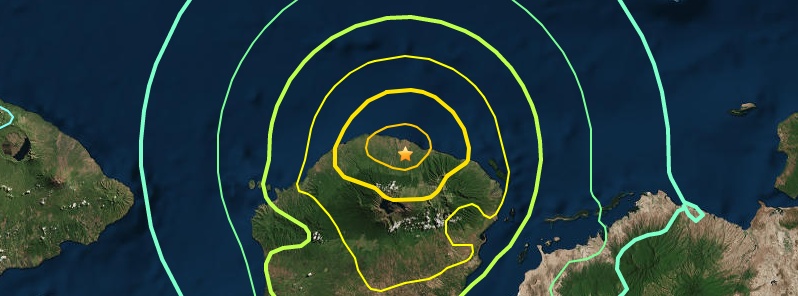
A very strong and shallow earthquake registered by the USGS as M6.9 hit Indonesia's Lombok region at 11:46 UTC on August 5, 2018 (18:46 local time). The agency is reporting a depth of 31 km (19 miles). EMSC is reporting M6.9 at a depth of 33 km (20 miles). BMKG is reporting M7.0 at a depth of 15 km (9.3 miles).
This earthquake can have a medium humanitarian impact based on the magnitude and the affected population and their vulnerability. It hit just a few days after shallow M6.4 on July 28 in which 17 people died.
The epicenter was located 2.4 km (1.5 miles) ESE of Loloan, 34.5 km (21.4 miles) NW of Labuan Lombok (population 10 000), 51.2 km (31.8 miles) NE of Mataram (population 318 647), 52.6 km (32.7 miles) NNE of Praya (population 35 183) and 66 km (41 miles) NE of Lembar (population 10 000).
This is just 14 km (8 miles) south of Rinjani stratovolcano.
There are 3 780 000 people living within 100 km (62 miles).
Some 180 000 people are estimated to have felt very strong shaking, 2 774 000 strong, 971 000 moderate and 14 940 light.
A brief tsunami warning was in effect after the quake.
Strong aftershocks are shaking the region.
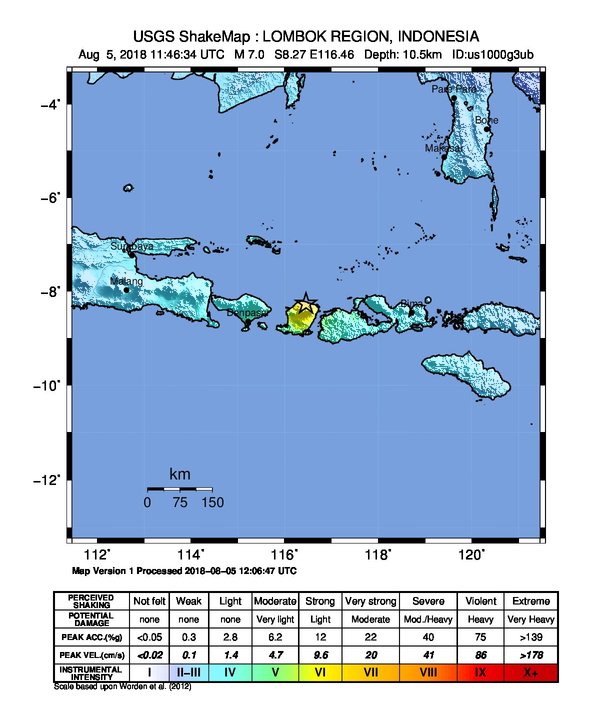
The USGS issued a yellow alert for shaking-related fatalities and economic losses. Some casualties and damage are possible and the impact should be relatively localized. Past yellow alerts have required a local or regional level response.
Estimated economic losses are less than 1% of GDP of Indonesia.
#Pemutakhiran,Tsunami akibat Gmp Mag:7.0SR, telah terdeteksi di Carik(18:48WIB)0.135m, Badas(18:54WIB)0.100m, Lembar(19:27WIB)0.090m #BMKG pic.twitter.com/2gBcvMUJ96
— BMKG (@infoBMKG) August 5, 2018
Overall, the population in this region resides in structures that are vulnerable to earthquake shaking, though resistant structures exist. The predominant vulnerable building types are unreinforced brick with concrete floor and concrete/cinder block masonry construction.
Recent earthquakes in this area have caused secondary hazards such as tsunamis that might have contributed to losses.
Estimated population exposure to earthquake shaking
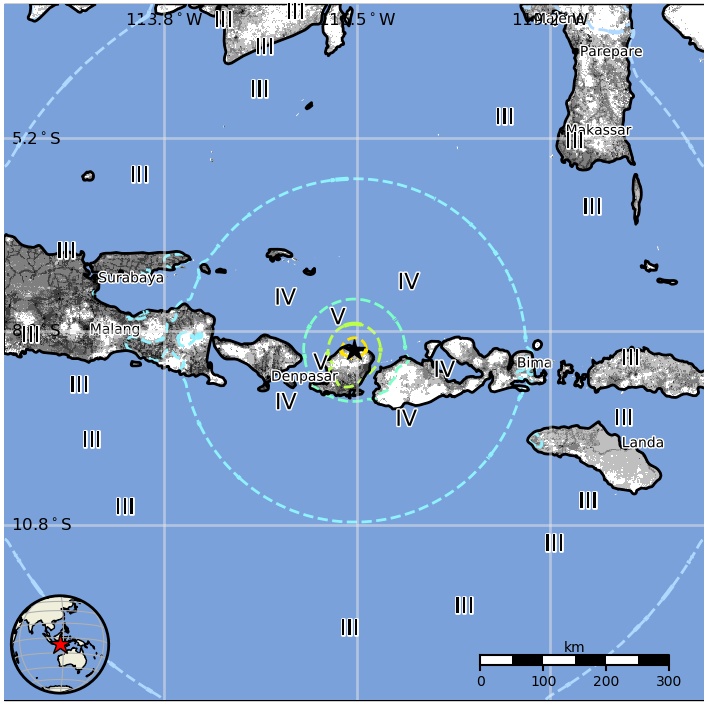
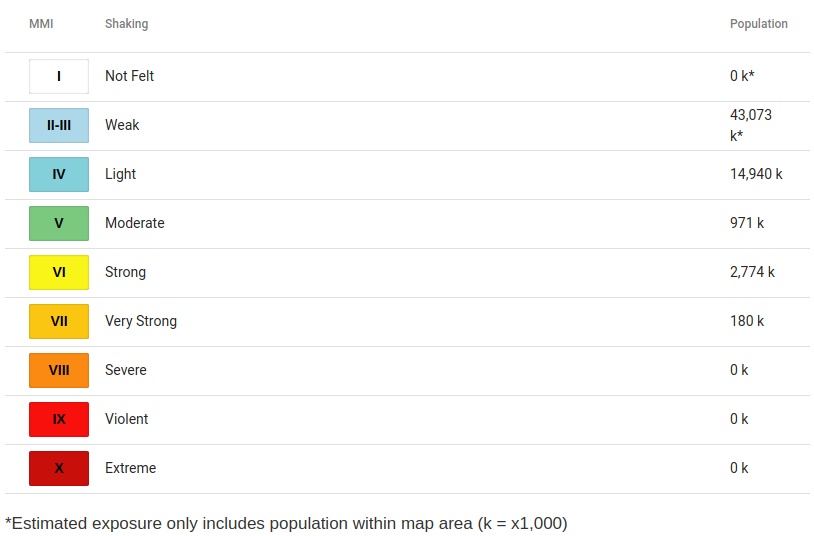
Selected cities exposed
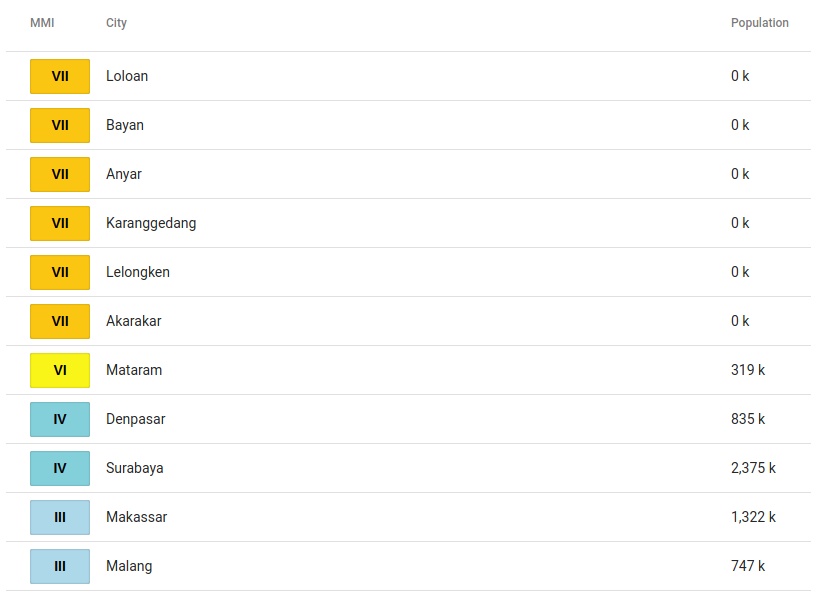
Regional seismicity
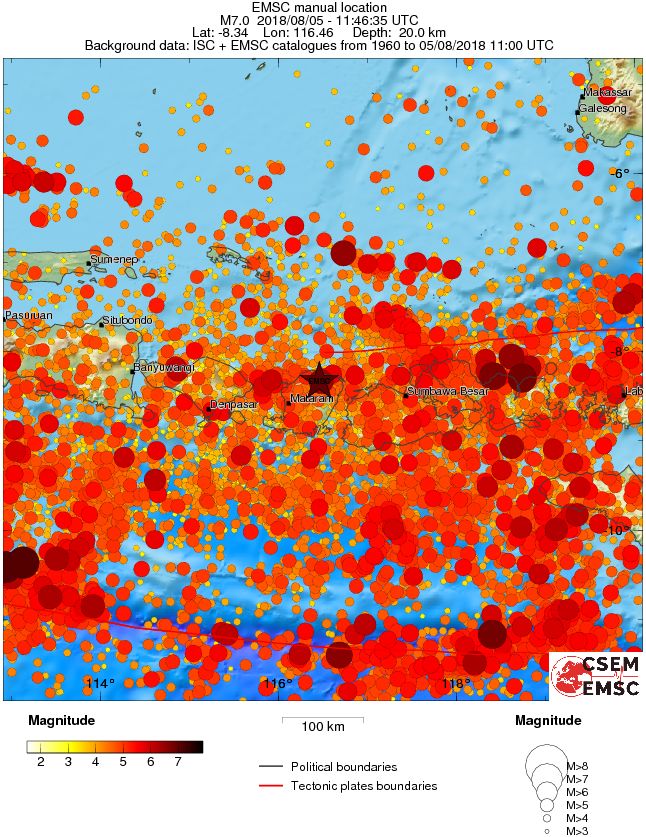
Ground failure
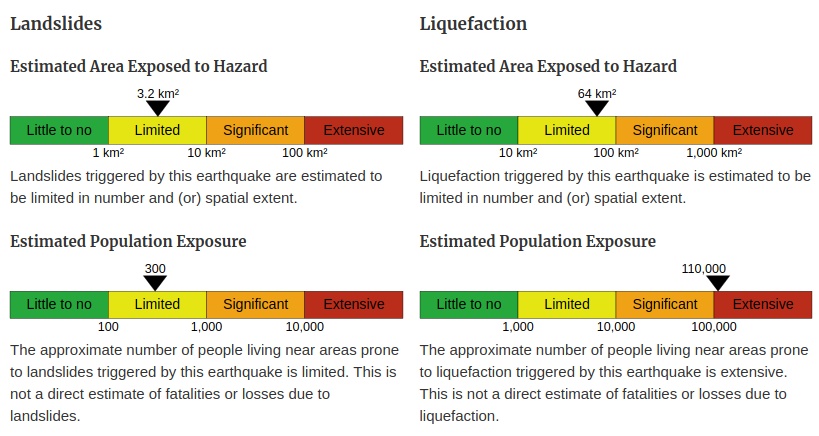
Geological summary
The quake occurred as the result of shallow thrust fault on or near The Flores Back Arc Thrust. Preliminary focal mechanisms for the earthquake indicates slip occurred on either a shallow, south-dipping thrust fault, or on a steep, north dipping reverse fault. At the latitude of this earthquake, the Sunda and Australia plates converge in a north-south direction at a rate of about 70 mm/yr. The location of this earthquake is consistent with it occurring as southward-oriented thrust faulting on the Flores Back Arc Thrust.
At the location of this event, the Sunda plate underthrusts the Indonesian Arc to the south, along the Flores Back Arc Thrust local to this earthquake, and along the Wetar Back Arc Thrust farther to the east. To the south, the Australia plate also underthrusts the arc to the north, along the Java Trench. This Flores region marks the transition between traditional oceanic plate subduction in the west (Australia plate beneath Sunda) to continental collision in the east. As a result, two opposite-verging thrust systems are evident in cross-sections, and the northward subducting slab of the Australia plate exists at depth beneath the Indonesian Islands and the Flores Sea. The focal mechanism solution and depth of this earthquake indicate it is associated with the Flores Back Arc Thrust system, rather than the deeper Australia slab.
In the region surrounding the August 5, 2018 earthquake, there have been six other events of M6.5 or larger over the previous century. Four of these are likely to have occurred on the back arc thrust system; a M6.5 in the Bali region to the west of Lombok in July 1976, and three events of M6.5, M6.5, and M6.6 in the Sumbawa region to the east of Lombok in November 2007 and November 2009. The Sumbawa earthquakes were associated with several deaths, hundreds of injuries, and hundreds of houses being destroyed.
Updates
An initial tsunami warning of waves of up to 50 cm (1.6 feet) was issued following the quake but later withdrawn.
This quake hit just a few days after strong and shallow M6.4 on July 28 which killed at least 17 people, injured more than 150 and destroyed thousands of homes.
Aftershocks were numerous and as large as M5.7.
The earthquakes caused remobilization of ash deposits on Rinjani as well as landslides. There were 1 226 visitors to the Mount Rinjani National Park Area at the time, and, according to news articles, about 690 climbers were on the volcano and had to be rescued. One person in the national park died from rockfalls.
The Alert Level remained at 2 (on a scale of 1-4) and the public was warned not to approach the crater within a 1.5-km radius (0.9 miles).
Kerusakan bangunan RSUD Karangasem Bali akibat gempa 7 SR dengan pusat gempa 18 km barat laut Lombok Timur. Intensitas gempa dirasakan VI MMI di Karangasem. Umumnya bangunan mengalami kerusakan jika diguncang gempa di atas VI MMI. pic.twitter.com/WX9XS1CVop
— Sutopo Purwo Nugroho (@Sutopo_PN) August 5, 2018
18:35 UTC
Agung Pramuja, head of the Disaster Mitigation Agency in the West Nusa Tenggara province confirmed 32 casualties by 18:32 UTC, Reuters reported. Pramuja said the agency was still collecting data on the injured.
Witnesses said the initial quake grew in intensity over several seconds, rattling windows and doors, and there were many aftershocks.
Bali and Lombok airports are operating normally despite minor damage, authorities said.
04:23 UTC, August 6
The death toll rose to 82. Most of the victims were killed by falling rubble in northern and western parts of Lombok.
Hundreds were injured and thousands of homes damaged.
08:57 UTC
The death toll rose to 91 and is still expected to rise as information come in from areas where thousands of buildings collapsed or were badly damaged, the National Disaster Mitigation Agency (BNPB) said.
Power and communications were cut in some areas of Lombok, and the military said it was sending in a vessel with medical aid, supplies and logistical support for the island.
The quake prompted an exodus of tourists.
22:05, August 8
The number of people killed reached 131, authorities said August 8. 1 477 people were seriously injured and 156 000 displaced. 42 239 houses were damaged as well as 458 schools.
The numbers are still expected to rise as data collection is still not completed.
09:11 UTC, August 9
A strong aftershock registered by BMKG as M6.2 hit Lombok, Indonesia at 05:25 UTC (12:25 WIB) on August 9, 2018. The agency is reporting a depth of 12 km (7.4 miles). USGS registered it as M5.9 at a depth of 10 km (6.2 miles).
According to the USGS, the epicenter of today's quake was located 23.2 km (14.4 miles) NNE of Mataram (population 318 674), 35.1 km (21.8 miles) NNW of Praya (population 35 183), 39.6 km (24.6 miles) NNE of Lembar (population 10 000), and 51.9 km (32.2 miles) WNW of Labuan Lombok (population 10 000).
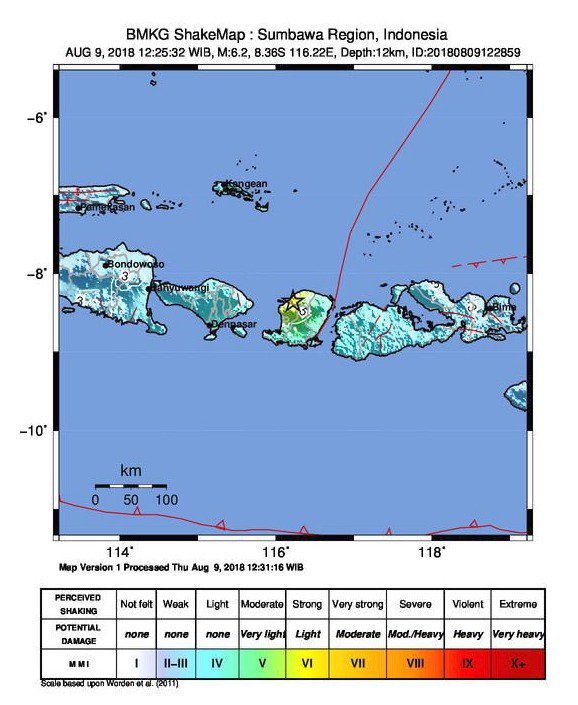
There are 4 740 000 people living within 100 km (62 miles) and 28 000 within 10 km.
This quake had no tsunami potential, authorities said.
Gempabumi susulan 6,2 SR baru saja terjadi di Lombok pada 9/8/2018 pukul 12.25 WIB. Pusat gempa 6 km barat laut Lombok Utara kedalaman 12 km. Tidak berpotensi tsunami. Guncangan dirasakan sedang hingga keras. BMKG mencatat gempa susulan hingga pagi tadi 355 kali gempa. pic.twitter.com/qXKKRpNjwm
— Sutopo Purwo Nugroho (@Sutopo_PN) August 9, 2018
Pengungsi dan masyarakat berhamburan keluar rumah merasakan guncangan keras dari gempa 6,2 SR pada 9/8/2018 pukul 12.25 WIB. Masyarakat masih trauma dengan gempa sebelumnya. Beberapa bangunan tambah rusak akibat gempa ini. pic.twitter.com/tC5j56lM7T
— Sutopo Purwo Nugroho (@Sutopo_PN) August 9, 2018
The BMKG registered a total of 334 aftershocks following the August 5 M7.0 Lombok earthquake by 14:00 UTC, August 8.
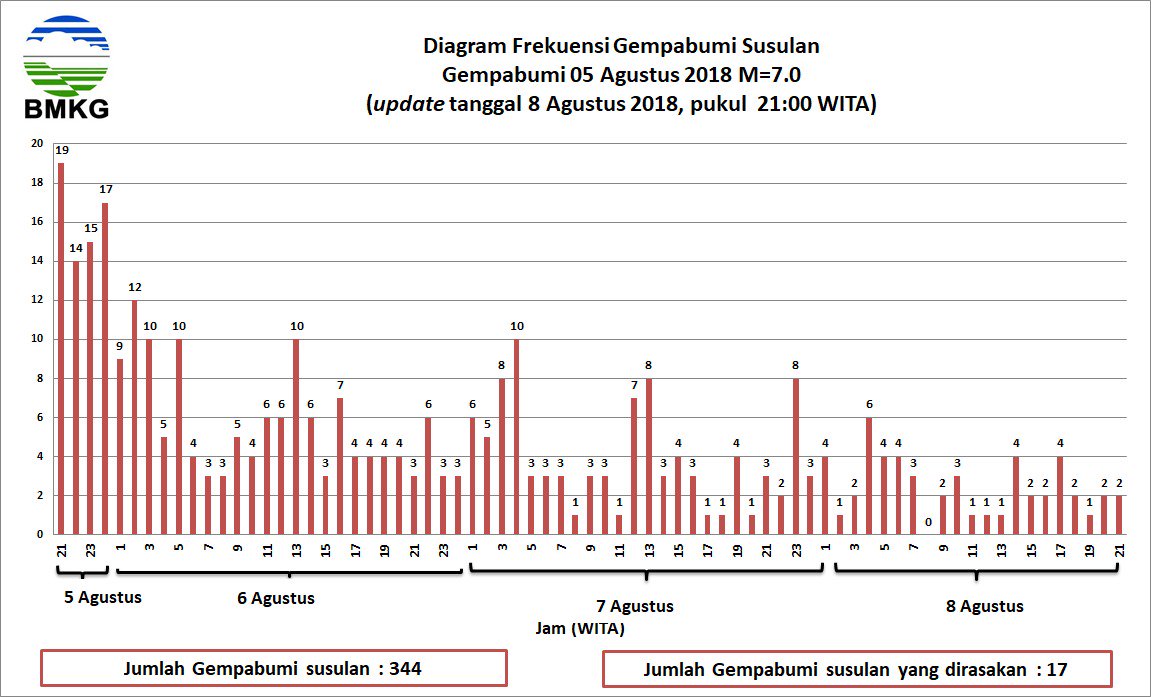
At 22:47 UTC (06:47 local time) on July 28, this same area was hit by M6.4 earthquake at a depth of 6.4 km (3.9 miles). At least 17 people were killed, 160+ injured and thousands of homes damaged.
22:15 UTC, August 9
The death toll reached 259 and is still expected to rise.
21:25, August 11
The death toll jumped to 387. More than 13 000 people were injured and more than 387 000 displaced. Thousands of buildings were damaged.
Sadly, the death toll is still expected to rise because there are still victims suspected of being buried by landslides and under rubble. There are also victims that have not been recorded and reported.
Most deaths occurred in the north of Lombok, where 334 people died and more than 200,000 people were forced out of damaged homes.
20:20 UTC, August 16
The death toll has surged to 460, officials said August 16.
A total of 7 773 people sustained injuries, 71 962 houses were damaged as well as 671 educational facilities and 52 health infrastructures.
Featured image credit: USGS

Commenting rules and guidelines
We value the thoughts and opinions of our readers and welcome healthy discussions on our website. In order to maintain a respectful and positive community, we ask that all commenters follow these rules.